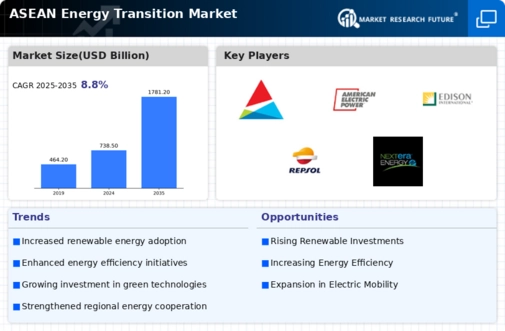Market Trends
Key Emerging Trends in the ASEAN energy transition market
One can note some significant trends characterizing the ASEAN energy transition market as such because of sustainable development in the region, global shifts toward renewable sources based on climate change challenges. A major shift in this regard is to promote renewable energy adoption as well as the diversification of the sources of power. To reduce the dependency on traditional fossil fuels and improve energy security, ASEAN nations are putting money into solar, wind turbines as well as Hydropower task. This trend matches with the region’s initiatives to capitalizing upon clean and renewable sources of energy that eventually helps in creating a more efficient, sustainable, and resilient power infrastructure. Energy storage solutions are a growing trend in the ASEAN market oriented to energy transition. The infrastructural development of the intermittent renewable sources, namely solar and wind is expected to increase. However, energy storage technologies like batteries are becoming more conspicuous with regard to enhancing stability and reliability on the grid. This wraps the understanding of how this region has acknowledged energy storage as one aspect that contributes in balancing supply and demand, managing imbalanced renewable power generation among other uses. The forms of trends in the ASEAN energy transition market are shaped by digitalization and smart grid technologies. The installation of smart metering infrastructure, the digital control platform, and smart grids allows for efficient flow management. This trend indicates the willingness of this region to improve energy efficiency, decrease transmission losses but make a more intelligent and resilient grid which is capable of allowing for growing use green energies. The development of policies and regulatory frameworks set by the government are prominent trends in ASEAN energy transition market. In ASEAN there are numerous countries that have set ambitious targets to increase the capacity of renewable energy, reduce emissions and improve the level of efficiency in their use. Governments are introducing support policies, incentives, and regulatory measures to encourage investments into clean energy projects as a way of fostering gradual transition towards low-carbon economy. The focus of this trend is on key regulatory frameworks that are likely to define the path of energy transition in the region. The ASEAN energy transition market marked a trend toward the popularity of decentralized energy systems and microgrids. The utilization of smaller-scale distributed energy resources enables greater autonomy in terms on power accessibility with respect to remote or detached locations. This tendency signifies the region’s movement to improve energy availability, sustainability, and dependability by broadening power mixes whereas decreasing reliance on centralized generation. Green production of hydrogen is evolving as a game changing trend in the ASEAN energy transition market.








Leave a Comment